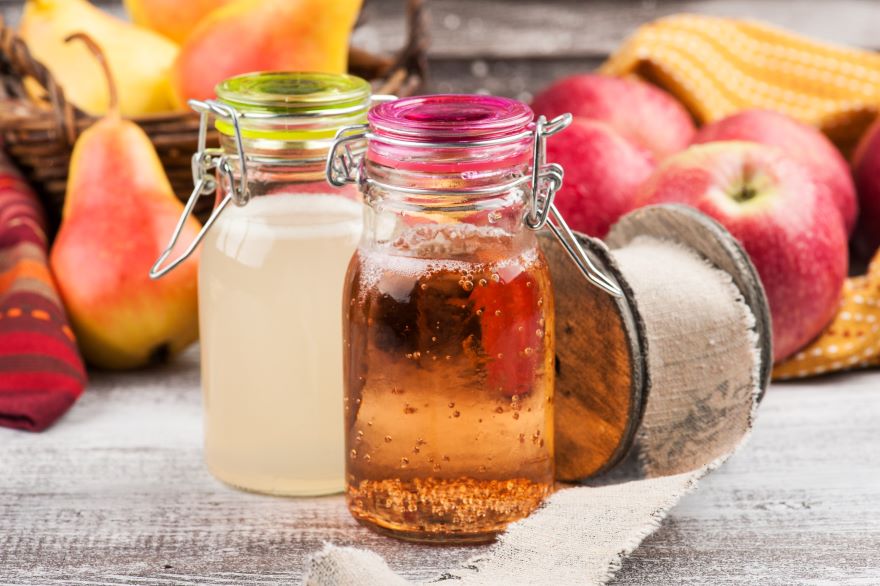ACV and white vinegar’s versatility made them popular in households and culinary applications. Understanding the differences between ACV and white vinegar is essential to maximize their potential benefits despite sharing acetic acid.
As its name suggests, people derive apple cider vinegar from apples, and it comes with a milder, fruity taste. Its dark amber color and cloudy appearance make it a popular choice for various cooking recipes and health remedies. People make white vinegar, also known as distilled or spirit vinegar, from grain alcohol, and it is clear in color. Its stronger, more acidic nature makes it an excellent choice for cleaning and preserving purposes.
Key Takeaways
- Apple cider vinegar has a milder, fruity taste, while white vinegar is stronger and more acidic
- The color and appearance of apple cider vinegar are distinct from the colorless white vinegar
- Both types of vinegar have versatile uses, such as in cooking, cleaning, and health remedies
Deriving the Differences Between White and Apple Cider Vinegar
Vinegar: What Is It?
Two fermentation processes, alcoholic and acidic fermentation, form vinegar, a liquid. Vinegar typically contains 4-8% acetic acid, with water and trace amounts of other compounds comprising the rest. People have utilized fermented foods, like vinegar, for centuries due to their tangy taste and potential health benefits.
The Origins of Different Vinegars
White vinegar and apple cider vinegar’s main distinction is their source materials and manufacturing methods. People derive white vinegar from distilled alcohol, often made from grain alcohol, resulting in a clear, colorless liquid. Its flavor is sharp and acidic, making it a versatile ingredient for cooking.
On the other hand, apple cider vinegar originates from fermented apple juice. “The mother” in ACV gives it a brown appearance, being a blend of cellulose and acetic acid bacteria. The mother imparts a fruity taste and numerous health benefits to apple cider vinegar, making it a popular choice for culinary and wellness applications.
In conclusion, white vinegar and apple cider vinegar differ significantly in origin, color, taste, and potential health advantages. They serve unique purposes in the world of cooking and natural remedies, making them distinct pantry staples.
Examining the Physical Characteristics
Color
The most distinguishable feature of apple cider vinegar and white vinegar is their color. Apple cider vinegar has a dark brown or amber color, while white vinegar is colorless and transparent. The difference in color is due to the ingredients used in making them. Apple cider vinegar comes from fermented apple juice while white vinegar comes from fermented grains like corn and wheat.
Taste
When it comes to flavor, there is a significant difference between apple cider vinegar and white vinegar. Apple cider vinegar has a milder, fruity taste that pairs well with various culinary dishes and provides potential health benefits. On the other hand, white vinegar has a more acidic and robust flavor mainly used for cleaning and preserving purposes. “The mother” in raw, unfiltered ACV may give it an even milder taste due to enzymes and proteins that influence flavor.
Texture
The texture of both types of vinegar is quite similar, as they are liquid in form. However, when comparing filtered and unfiltered apple cider vinegar, you might notice some differences. Unfiltered apple cider vinegar, which contains “the mother,” may appear cloudier compared to its filtered counterpart. In contrast, people make white vinegar almost always clear, regardless of whether they filter it or not.
Chemical Components’ Breakdown
Acidity
Let’s start by discussing the acidity difference between apple cider vinegar and white vinegar. ACV contains about 5-6% acetic acid, while white vinegar has a higher concentration of about 5-10%. This makes white vinegar more acidic than its apple-based counterpart.
Nutritional Value
ACV has an advantage over white vinegar nutritionally due to its vitamin and mineral content, such as potassium and magnesium. Additionally, good bacteria and probiotics in apple cider vinegar can help with digestion. White vinegar, on the other hand, is primarily water and acetic acid, so it does not offer much nutritional value.
Antioxidant and Antimicrobial Properties
Apple cider vinegar is known for its antioxidant and antimicrobial properties. The presence of various organic acids, including acetic acid, in apple cider vinegar can potentially help manage blood pressure and blood sugar levels, attributing to this benefit. Furthermore, apple cider vinegar may hold some benefits for digestion, thanks to its probiotic content.
In conclusion, ACV and white vinegar differ in color, taste, acidity, nutritional value, and potential benefits. Understanding these differences helps you choose the right vinegar for cooking, health, and cleaning.
In Kitchen: Their Uses in Diverse Food Items
For Cooking
When it comes to cooking, I often use both apple cider vinegar and white vinegar for different purposes. ACV’s milder, fruity taste makes it suitable for adding flavor to soups, stews, and even some desserts. People use white vinegar, being stronger and more acidic, in pickling vegetables and fish and in certain cuisines for tangy taste.
In Baking
In baking, I usually prefer using apple cider vinegar. Its milder taste doesn’t overpower the other ingredients and can enhance the overall flavor. Combining ACV with baking soda helps baked goods rise and become fluffy as it works as a leavening agent.
People can use white vinegar in baking, but its strong, acidic taste can come through in the final product. I use white vinegar sparingly and more often when I need a stronger acidic component to react with other ingredients.
As Dressings, Marinades, and Sauces
Both ACV and white vinegar have distinct roles in preparing dressings, marinades, and sauces. Apple cider vinegar, with its fruity and tangy taste, is perfect for making salad dressings, marinades, and fruit-based sauces. Its unique flavor can bring a freshness and lightness to the dish.
White vinegar, also known as spirit vinegar, is suitable for making more acidic and bold-flavored marinades and sauces for robust meats or stronger flavored vegetables.. Its sharp taste cuts through the richness of the ingredients and balances the overall flavor profile.
In summary, ACV and white vinegar have unique uses based on their flavors, acidity, and cooking techniques. Having both ACV and white vinegar at my disposal allows me to experiment with various delicious food items.
Utilizing Vinegar in House Cleaning
When I clean my house, I prefer using vinegar as a natural and effective alternative to harsh chemicals.ACV and white vinegar’s acidity helps in cutting through grime, grease, and breaking down stains, making them excellent cleaners.
I use white vinegar for its higher acetic acid content, usually around 5-10%, making it more potent in tackling tough stains. White vinegar’s clear color prevents it from leaving residues or causing discoloration during cleaning, unlike ACV.
For general cleaning, I mix equal parts of white vinegar and water in a spray bottle. This solution works wonders in disinfecting surfaces, removing odors, and shining glass and mirrors. To tackle stubborn stains, I apply undiluted vinegar, let it sit for a few minutes, then scrub and wipe clean.
People can use ACV in household cleaning, but its slightly lower acidity (around 5-6%) makes it less powerful. However, I find it effective as a natural deodorizer, especially for musty or stale smells. A bowl of ACV left in a room overnight significantly reduces odors, making the space smell fresh and clean.
Lastly, I find vinegar useful for cleaning appliances and fixtures. For example, descaling a kettle or coffee maker by running a mixture of water and white vinegar through it. Cleaning showerheads with a vinegar soak also helps remove mineral deposits and prolongs their functionality.
In conclusion, both white and apple cider vinegars are valuable in household cleaning. While white vinegar is more potent for tackling stains and disinfecting surfaces, apple cider vinegar works well for neutralizing odors. Regardless of the type you choose, these natural cleaners are eco-friendly, safe, and efficient options for maintaining a clean and healthy home.
Health Benefits of Vinegar Types
Weight Loss
Some people believe that apple cider vinegar can aid in weight loss by increasing satiety and metabolism. I’ve come across a study suggesting its effectiveness in managing type 2 diabetes alongside other herbal remedies like fenugreek seeds. While evidence supports the weight loss benefits of apple cider vinegar, people should remember that no single ingredient alone will lead to significant weight loss, but rather they should integrate it into a balanced diet and exercise routine.
Blood Sugar Control
Both apple cider vinegar and white vinegar have shown potential in managing blood sugar levels. Acetic acid present in both vinegar types is known to slow down the digestion of carbohydrates, resulting in a steadier release of glucose into the bloodstream. This, in turn, may help manage blood sugar levels. Apple cider vinegar in particular has gained attention for its potential in this area, yet again, moderation and consistency are key to experiencing the best results.
Heart Health
The benefits of these vinegar types also extend to heart health. People credit apple cider vinegar with helping to lower cholesterol and triglyceride levels. This is because it contains beneficial compounds such as chlorogenic acid, known for its antioxidant and anti-inflammatory properties. White vinegar, while it may not have the same level of nutrients as apple cider vinegar, still contains acetic acid, which could contribute to improved blood pressure and overall well-being.
In sum, both apple cider vinegar and white vinegar offer health benefits in areas such as weight loss, blood sugar control, and heart health. It’s crucial to remember that incorporating these vinegars into the diet should be accompanied by a balanced lifestyle and not considered a stand-alone solution for achieving optimal health.
Unique Features of Apple Cider Vinegar and White Vinegar
In my exploration of apple cider vinegar and white vinegar, I’ve discovered they have distinct features that distinguish them from each other. One key difference between these two types of vinegar lies in their color and taste profile. Apple cider vinegar has a dark brown or amber color, with a fruity, milder taste, whereas white vinegar is white, clear, and has a sharper taste.
When it comes to organic variations, apple cider vinegar is often available in organic, raw forms. Raw apple cider vinegar typically contains “the mother,” a culture of beneficial bacteria with various supposed health benefits, while people do not typically find white vinegar in organic or raw forms, as they mainly use it for cleaning and preserving purposes.
In terms of nutrition, apple cider vinegar is known to be a potent digestive aid, helping to improve digestion and reduce symptoms like bloating and heartburn. Additionally, it has been suggested that apple cider vinegar may also possess certain antimicrobial and antioxidant properties, making it a staple health product in many households. White vinegar, though not as nutritionally beneficial as apple cider vinegar, does serve its purpose in culinary uses and cleaning applications.
Apple cider vinegar and white vinegar can both be used in the kitchen, but they serve different purposes. Here’s a quick comparison of their culinary uses:
- Apple Cider Vinegar: Commonly used for dressings, vinaigrettes, marinades, and seasonings for veggies.
- White Vinegar: Typically used for pickling, preserving, and as a strong cleaning agent.
To sum up, apple cider vinegar and white vinegar have unique features that define their uses and benefits. I’ve found that apple cider vinegar is more associated with potential health benefits and is often available in organic, raw forms, while white vinegar is mainly used for cleaning and preserving.
How To Choose Between these Two Types of Vinegar
When I want to decide whether to use apple cider vinegar or white vinegar in my cooking or health routine, I consider several factors. Getting acquainted with the unique properties of each type of vinegar is crucial.
Firstly, I pay attention to the taste profile. Apple cider vinegar has a distinct tangy fruity flavor, while white vinegar has a sharp and more acidic taste. Depending on the desired flavor for a dish or culinary purpose, I choose the appropriate vinegar. For instance, apple cider vinegar is often my go-to for salad dressings and sauces, while white vinegar works well for pickling and cleaning purposes.
Secondly, sugar content is another aspect I take into account. Apple cider vinegar is made through the fermentation of apple cider, which contains natural sugars. Though these sugars are mostly converted to acetic acid during fermentation, traces may remain, adding mild sweetness to the taste. In contrast, white vinegar is typically made from distilled grains and has a lower sugar content. For recipes that call for a less sweet taste or for any restrictions due to health reasons, I choose white vinegar.
As someone who prefers to consume products with health benefits in mind, I consider the potential advantages each vinegar offers when making my choice. Apple cider vinegar is believed to have possible health benefits such as aiding in digestion and lowering blood sugar levels, while white vinegar is generally regarded as neutral in terms of health. Hence, I tend to use apple cider vinegar when the purpose involves health.
Lastly, I take dilution into consideration. Both apple cider vinegar and white vinegar have distinctive flavors that can overpower a dish if used undiluted. To maintain the overall taste of my recipes, I usually dilute them with water, especially when incorporating stronger-tasting white vinegar. This helps achieve the right balance of flavors and acidity without overpowering the dish.
By keeping these factors in mind, I confidently choose between apple cider vinegar and white vinegar to meet my culinary and health needs while staying true to my preferred taste profiles.
Conclusion
In my research, I’ve found that the main differences between apple cider vinegar and white vinegar lie in their acidity levels, color, taste, and uses. Apple cider vinegar contains about five to six percent acetic acid, while white vinegar contains five to ten percent, making white vinegar more acidic overall. The color difference is quite apparent, with apple cider vinegar being dark brown or amber, and white vinegar being white and clear.
As for their taste, I’ve observed that apple cider vinegar has a milder and fruity taste, which makes it more suitable for cooking and incorporating into recipes. White vinegar, on the other hand, has a stronger and more acidic taste, and it works well for cleaning and preserving purposes.
I also learned that apple cider vinegar has some potential health benefits, such as blood sugar control and digestive aid, owing to its origins from fermented apple cider. This gives it an edge for those who are health-conscious and want to make better decisions in their daily consumption habits.
To sum up my findings, understanding the differences between apple cider vinegar and white vinegar can be beneficial for various reasons. Knowing their distinct properties can help anyone make informed choices when deciding which vinegar type to use in cooking, cleaning, or for personal health. It’s important to remember, though, that while there are differences, both vinegars have their unique advantages, so always choose based on your specific needs and preferences.
Frequently Asked Questions
Is one vinegar better for weight loss?
From a weight loss perspective, there isn’t a significant difference between apple cider vinegar and white vinegar. Both vinegars contain acetic acid, which may have some potential benefits for weight management. However, it’s essential to remember that I am not a nutrition expert and following a balanced diet, and regular exercise is the key to a successful weight loss journey.
How do their tastes compare?
Apple cider vinegar has a milder, fruity taste, which makes it suitable for use in recipes, dressings, and sauces. On the other hand, white vinegar has a stronger, more acidic taste, often used for cleaning and preserving. Their distinct flavors make them ideal for specific uses in the kitchen.
Can they be interchanged in baking?
Although apple cider vinegar and white vinegar can occasionally be substituted for one another, there are differences between them that may affect your baking outcome. Substituting one for the other may alter the taste and acidity of the final product. If you’re unsure, it’s best to refer to the recipe for guidance on which vinegar to use.
Which one is more suitable for laundry?
For laundry purposes, white vinegar is generally the preferred choice due to its higher acetic acid content and strong cleaning properties. It can be used to remove stains, soften clothes, and even reduce odors. I would not recommend using apple cider vinegar for laundry, as it might leave behind a residue or slight discoloration.
Which vinegar is preferred for pickling?
When it comes to pickling, white vinegar is usually the vinegar of choice due to its clear color and higher acidity, which helps preserve the pickles. However, some recipes may call for apple cider vinegar for its milder taste and fruity flavor. Be sure to follow the recipe’s guidelines for the best pickling outcome.
Is one more effective for hair care?
Apple cider vinegar is often favored for hair care treatments, as it has a lower acidity level and contains a small amount of nutrients. Many people believe that using apple cider vinegar as a hair rinse can improve shine and balance the scalp’s pH. On the other hand, I would not recommend using white vinegar for hair care, as its stronger acidity could cause irritation or damage.

*We may earn a commission for purchases made using our links. Please see our disclosure to learn more.



